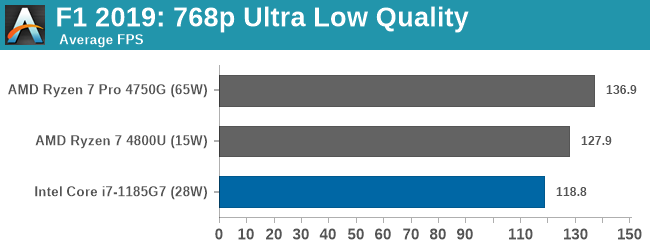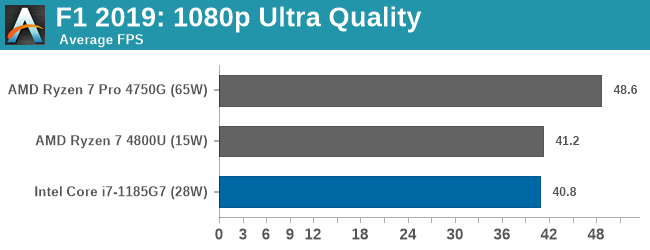Intel’s Tiger Lake 11th Gen Core i7-1185G7 Review and Deep Dive: Baskin’ for the Exotic
by Dr. Ian Cutress & Andrei Frumusanu on September 17, 2020 9:35 AM EST- Posted in
- CPUs
- Intel
- 10nm
- Tiger Lake
- Xe-LP
- Willow Cove
- SuperFin
- 11th Gen
- i7-1185G7
- Tiger King
Xe-LP GPU Performance: F1 2019
The F1 racing games from Codemasters have been popular benchmarks in the tech community, mostly for ease-of-use and that they seem to take advantage of any area of a machine that might be better than another. The 2019 edition of the game features all 21 circuits on the calendar, and includes a range of retro models and DLC focusing on the careers of Alain Prost and Ayrton Senna. Built on the EGO Engine 3.0, the game has been criticized similarly to most annual sports games, by not offering enough season-to-season graphical fidelity updates to make investing in the latest title worth it, however the 2019 edition revamps up the Career mode, with features such as in-season driver swaps coming into the mix. The quality of the graphics this time around is also superb, even at 4K low or 1080p Ultra.
To be honest, F1 benchmarking has been up and down in any given year. Since at least 2014, the benchmark has revolved around a ‘test file’, which allows you to set what track you want, which driver to control, what weather you want, and which cars are in the field. In previous years I’ve always enjoyed putting the benchmark in the wet at Spa-Francorchamps, starting the fastest car at the back with a field of 19 Vitantonio Liuzzis on a 2-lap race and watching sparks fly. In some years, the test file hasn’t worked properly, with the track not being able to be changed.
For our test, we put Alex Albon in the Red Bull in position #20, for a dry two-lap race around Austin.


In this case, at 1080p Ultra, AMD and Intel (28W) are matched. Unfortunately looking through the data, the 15 W test run crashed and we only noticed after we returned the system.











253 Comments
View All Comments
JfromImaginstuff - Friday, September 18, 2020 - link
Intel is planning to release a 8 core 16 thread SKU, confirmed by one of their management can't remember his name but when that'll reach the market is a question markRedOnlyFan - Friday, September 18, 2020 - link
With the space and power constraints you can choose to pack more cores or other features that are also very important.So Intel chose to add 4c + the best igpu + AI + neural engine + thunderbolt + Wi-Fi 6 + pcie4.
Amd chose 8cores and a decent igpu.
So we have to choose between raw power and more useful package.
For a normal everyday use an all round performance is more important. There are millions who don't even know what cinebench is for.
Spunjji - Friday, September 18, 2020 - link
Weird that you're calling it "the best iGPU" when the benchmarks show that it's pretty much equivalent to Vega 8 in most tests at 15W with LPDDR4X, which is how it's going to be in most notebooks.Funny also that you're proclaiming PCIe 4 to be a "useful feature" when the only thing out there that will use it in current notebooks is the MX450, which obviates that iGPU.
I could go on but really, Thunderbolt is the only one I'd say is a reasonable argument. A bunch of AMD laptops already have Wi-Fi 6
JayNor - Saturday, September 19, 2020 - link
but Intel has lpddr5 support built in. Raising memory data rate by around 25% is something that should show up broadly as more performance in the benchmarks.Intel's Tiger Lake Blueprint Session benchmarks were run with lpddr4x, btw, so expect better performance when lpddr5 laptops become available.
https://edc.intel.com/content/www/us/en/products/p...
Spunjji - Saturday, September 19, 2020 - link
I understand and agree. My point was, what does "support" matter if it's not actually useable in the product? This will be an advantage when devices with it release. Right now, it's irrelevant.abufrejoval - Friday, September 18, 2020 - link
I'd say going for the biggest volume market (first).Adding cores costs silicon real-estate and profit per wafer and the bulk of the laptop market evidently doesn't want to pay double for eight cores at 15 Watts.
Being a fab, Intel doesn't seem to mind doing lots of chip variants, for AMD it seems to make more sense to go for volume and fewer variants. The AMD 8 core APU covers a lot of desktop area, but also laptops, where Intel just does distinct 8 core chip.
Intel might even do distinct iGPU variants at higher CPU cores (not just via binning), because the cost per SoC layout is calculated differently.... at least as long as they can keep up the volumes.
I'm pretty sure they had a lot of smart guys run the numbers, doesn't mean things might not turn out differently.
Drumsticks - Thursday, September 17, 2020 - link
Regarding:Compromises that had been made when increasing the cache by this great of an amount is in the associativity, which now increases from 8-way to a 20-way, which likely increases conflict misses for the structure.
On the L3 side, there’s also been a change in the microarchitecture as the cache slice size per core now increases from 2MB to 3MB, totalling to 12MB for a 4-core Tiger Lake design. Here Intel was actually able to reduce the associativity from 16-way to 12-way, likely improving cache line conflict misses and improving access parallelism.
---
Doesn't increasing cache associativity *decrease* conflict misses? Your maximum number of conflict misses would be a direct mapped cache, where everything can go into only one place, and your minimum number of conflict misses would be a fully associative cache, where everything can go everywhere.
Also, isn't it weird that latency increases with the reduced associativity of the new L3? I guess the fact that it's 50% larger could have a larger impact, but I'd have thought reducing associativity should improve latency and vice versa, even if only slightly.
Drumsticks - Thursday, September 17, 2020 - link
Later on, there is:The L2 seemingly has gone up from 13 cycles to 14 cycles in Willow Cove, which isn’t all that bad considering it is now 2.5x larger, even though its associativity has gone down.
---
But in the table, associativity is listed as going from 8 way to 20 way. Is something mixed up in the table?
AMDSuperFan - Thursday, September 17, 2020 - link
How does this compare with Big Navi? It seems that Big Navi will be much faster than this right?Spunjji - Friday, September 18, 2020 - link
🤡